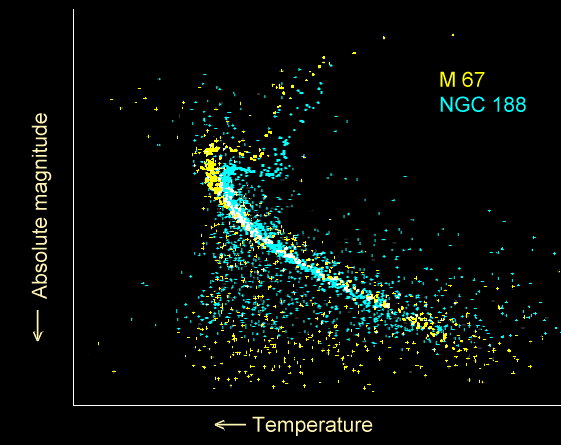
Caption: A Hertzsprung-Russell (HR) diagram for 2 open clusters of stars (M67 in constellation Cancer (CNC); age 3.2--5.0 Gyr) and NGC 188 in constellation Cepheus (CEP); age ∼ 6.8 Gyr) showing the main-sequence turn-offs.
Features:
- Star clusters
(both open clusters
and globular clusters)
are formally distinct from
dwarf galaxies)
by being embedded in
galaxies
and by having all theuir
stars formed in
one star-formation episode
of typically a few tens of millions of years.
Actually, the distinction is muddified by the facts that some star clusters show some evidence of generations of star formation and that dwarf galaxies are often inside galactic halo and are galaxy quenched (i.e., have star formation turned off probably permanently in most cases).
But, nevertheless, usually the astronomical objects (star clusters and dwarf galaxies) can be distinguished.
- Since a star cluster
has all stars formed
at one time relative to cosmic time),
its HR diagram
truncates at
the high stellar-mass end beyond which
all stars have already evolved off the
main sequence.
Stars initially greater than 8 M_☉ (i.e., evolutionary supergiants which start as main-sequence O stars and some main-sequence B stars) will have exploded as core collapse supernovae effectively at time zero in the star cluster's star formation region since their lifetimes are < ∼ 30 Myr. The supernova ejecta will become a supernova remnants that disperse after tens of the thousands of years. The compact remnant will be neutron stars or black holes which are quite often virtually undetectable.
Less massive stars than 8 M_☉ that have left the main sequence will be one of the following phases: subgiants, red giants, horizontal branch stars, asymptotic giant branch (AGB) stars, or white dwarfs.
- The age of a star cluster
can be determined from fitting a
stellar isochrone
to the
turn-off.
A stellar isochrone is an HR diagram for synthetic star cluster aged by computer simulation.
It is a theoretical main sequence up to the turn-off above which the curve extends showing the distribution of post-main-sequence stars.
- The age
of M67 has been determined to be in the range
3.2--5 Gyr
and that of NGC 188 is ∼ 6.8 Gyr.
They are both quite old for being open clusters. Most open clusters disperse due to on the gravitational perturbations on the time scale of a few to hundreds of megayears (see Wikipedia: Open cluster: Evenutal fate).
- In constrast to
star clusters
(and stars therein),
the ages of isolated
stars
multiple-star systems
are hard to determine.
In particular, main-sequence stars do NOT change much in observable characteristics during their main-sequence lifetimes. Core transformantion of hydrogen to helium-4 (He-4) is, of course, unobservable.
- The upshot is that
star clusters
(both open clusters
and globular clusters)
are very important in studying the evolution of the
observable universe.
Image link: Wikimedia Commons: File:Open cluster HR diagram ages.gif.
Local file: local link: star_hr_turn_off.html.
File: Star file: star_hr_turn_off.html.